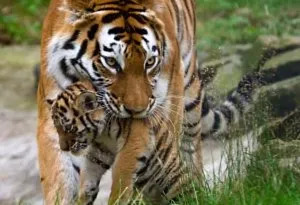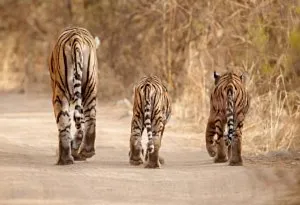In this Article
Beautiful, strong and fast, tigers are a force to be reckoned with. Native to Asia and eastern Russia, their scientific name is Panthera tigris and these animals are a part of the feline family, which basically means they are just really big cats! Tigers do share similar characteristics with the common house cat but they are much bigger and therefore much more dangerous. They prefer to live and hunt alone.
Physical Features of Tiger
Tigers can weigh around 300 kilograms and measure to a length of 3.3 meters. They are the biggest cat species in the world. Tigers have a unique coat that is most commonly a reddish or orange shade with black stripes. Females are smaller than the males of the species, and the northern tigers are found to be much larger than the ones in the south. For example, Bengal tigers are much larger in size than Sumatran Tigers, which are native to Indonesia. Every tiger has around 30 sharp teeth and is known to have the biggest canines amongst all the big cats. Their legs are muscular, and they have very sharp claws.
Types of Tigers
While there are some sub-species of tigers that have gone extinct, there are currently six in existence.
1. The Bengal Tiger (Panthera tigris tigris)
These tigers are native to India, though they are also found in Nepal, Bhutan and Bangladesh. They have the standard orange and black striped coats, but there have been cases of tigers being born with white and black striped fur and blue eyes. This is a genetic mutation and “White Tigers” are not a separate sub-species.
2. The Siberian Tiger (Panthera tigris altaica)
These tigers are found mainly in certain parts of Russia, which is very cold. In order to survive, these tigers have extremely thick skin and their coat is very dense.
3. The Indochinese Tiger (Panthera tigris corbetti)
These tigers are smaller in size and are more solitary creatures that avoid populated areas as much as they can.
4. The Malayan Tiger (Panthera tigris jacksoni)
Their native home is distributed among the tropical forests of the Malay Peninsula. When it is available, this tiger hunts and preys on livestock, causing there to be much conflict between them and humans.
5. The South China Tiger (Panthera tigris amoyensis)
Native to South China, these tigers have not been spotted anywhere in the wild for more than twenty-five years! There are only a few remaining in captivity.
6. The Sumatran Tiger (Panthera tigris sumatrae)
These tigers are native to Sumatra and are one of the smaller sub-species of tigers.

How Do Tigers Give Birth to Their Cubs?
Here are some interesting facts on how their mother gives birth to and looks after her offspring as well as some baby tiger (called cubs) facts for kids:
- Female tigers are pregnant for three and a half months before giving birth to a litter of three or four cubs.
- Mama tigers prepare a den that is in a safe and secluded spot to give birth to her cubs. These include caves, hollows of trees or even dense grasses. She will often find a place with a soft ground or dry leaves and grass.
- Male tigers do not help in birthing or rearing the cubs. The mother does it all on her own.
- The cubs are born blind but their eyes open between six to twelve days after birth.
- The mortality rate of tiger cubs is very high. Often only half live to reach maturity.
- Tiger cubs breastfeed until they are six to eight weeks old, which is when their mama weans them onto solid food.
- Mama tigers teach their cubs to hunt at eight weeks, but they do not go out with her to hunt until they are at least six months old.
- Tigers leave their mothers to look for their own territories at the age of two years, at which age they are considered to be proper adult tigers.
- A tigress will give birth to a new litter once every two and a half years, but if for some reason her entire litter dies, she is once again ready to mate within five months.

How Do They Form Their Own Territories?
Tigers form their territories in the following way:
- Like most animals, tigers urinate or use anal gland secretions to mark their territories.
- Tigers, like lions, roar to announce that a certain area belongs to them.
- Tigers tend to move around only in their own territories, which is why they choose a habitat that can satisfy all their needs.
- Tigers choose territories that are close to bodies of water as they enjoy a good swim and it helps them to cool off.
Food Habits of Tigers
Tigers are carnivorous and therefore prefer to eat meat. Here are some hunting and food habits of tigers:
- In the wild, tigers hunt medium to large animals.
- In India, tigers prey on chital, domestic buffalo, water buffalo, gaur and wild boar.
- Siberian tigers prey on moose and deer.
- Sumatran tigers feed on sambar, muntjac and Malayan tapir.
- Tigers also eat vegetation.
- They hunt alone rather than in groups and rely on their sight rather than their sense of smell. Their coats provide them with a certain amount of camouflage, especially in areas where there is long grass. This helps them to get really close to their prey without being detected.
- They are very patient hunters and can wait for their prey for hours, often launching an attack when least expected.
- Female tigers only hunt within their territories whereas the males hunt anywhere they choose.
How Long Do Tigers Live?
Though the average lifespan for tigers is around eight to ten years in the wild, they have been known to live for as long as 26 years in captivity. This is because they face many dangers in the wild that prevents most of them reaching maturity. Some of these dangers include starvation due to a shortage of prey, fighting over territory and being unable to defend themselves when they are old and when they are cubs, thereby making them prey for others such as packs of wild dogs and bears. Siberian tigers live for 10 to 15 years in the wild but can live up to 22 years in captivity.

Are Tigers Endangered?
Sadly, human beings are causing tigers to become extinct. They are being hunted mainly for their beautiful fur coats. Another way mankind is responsible is by destroying their natural habitats; without a proper habitat, these animals will not survive in the wild due to a shortage of prey and territories.
Other Must Know Facts of Tigers for Children
Here are some other interesting tiger facts for kids:
- Tigers need to eat at least five kilograms of food each and every day but can sometimes even eat up to thirty kilos.
- A group of tigers is called a “streak” or an “ambush”.
- Being such good swimmers, tigers can swim for up to six kilometres.
- Tigers usually hunt during the night.
- Tigers can reach speeds up to 65kph (40 mph).
- Tigers can jump over five meters high.
- A liger is a hybrid between a lion and a tiger. They are also known as tigons.
- Tiger stripes are unique, and no two tigers have the same pattern.
- Tigers do not eat their entire prey in one day. They eat as much as they need for the day and then bury it under dirt and leaves. When they need to eat next, the uncover it and eat.
- The sabre tooth tiger is the oldest tiger sub-species. A few sabre tooth tiger facts for kids include that it went extinct at the end of the ice age, which was around 10,000 years ago; they have extremely long canine teeth which is what they were named for, and the scientific name for the sabertooth tiger is “Smilodon”.
A couple of endangered tiger facts for kids are:
- The Caspian, Bali and Javan tiger sub-species became extinct in the last century
- The tiger population today is only 7% of what it was less than a hundred years ago
Tigers are a rich part of the Indian culture, not only because they are the most popular and largest of all tiger sub-species originates from the Indian sub-continent, but also because they are the national animal. Around the world, tiger species are becoming extinct as more and more of their habitat is being destroyed to make way for human settlements. As humans, it is our responsibility to do all that we can to help tiger populations to survive around the world; otherwise, we are in danger of losing these magnificent creatures forever.









